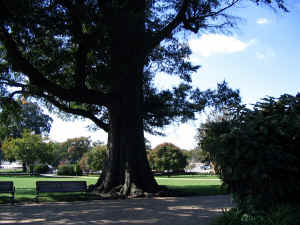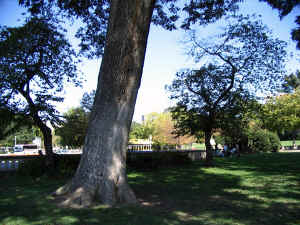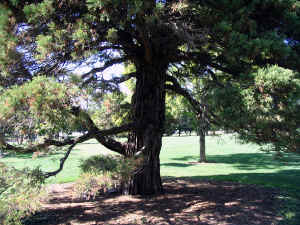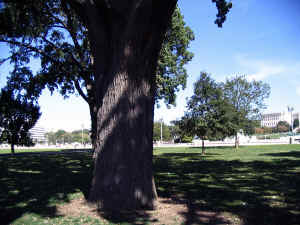Trees of Washington D.C. - the Capitol Region
Greetings!
Each year, great numbers of tourists visit The Mall in
Washington D.C.
to see the various monuments and museums that line the streets
of this
impressive city. D.C. is steeped in history and is a great place
to
visit even if you are there mostly for to see examples of
nature, which
is surprising for a city. Old trees live among equally old
buildings and
monuments, silent witnesses to years of history that have passed
under
their limbs and leaves.
This article will focus on the area around the Capitol Building,
the
grounds of which house a good number of old and massive trees,
many of
them native to the United States.
- Northern Red Oak: A great number of these line the roads and
open
areas between Union Station (how I get too and from D.C. from
points
northward) to the Capitol Building. Most of the red oaks here
are not
terribly old, though they are still older than the average tree
on a
suburban lot. An increasing variety of other oak species is
being
planted in the area, which is good since it should help get away
from
the near mono-culture of northern red oak.

Capitol Willow Oak -
20'4" CBH X 105.2' HGT X 90' AVG spread
- Willow Oak: The first truly huge, native tree one will come
across
when walking from Union Station to the Capitol. There, on the
northward
side of the Capitol, stands a monstrous willow oak. While the
tree's
height and spread are respectable, but not tremendous (since it
is
open-grown), it's girth is rather staggering. I'm quite sure it
is over
5-feet in diameter, with a big root structure holding it in
place. Truly
an impressive tree that seems to stand like a pillar holding up
the
heavens.
- Black Walnut: A modest-size black walnut grows opposite the
path from
the huge willow oak. It is not very large or impressive in size,
but it
is worthy of note.

Capitol Pecan
- Pecan: A large pecan tree stands amid some other Northern Red
Oaks if
one heads up the path, away from the Capitol, from the huge
Willow Oak.
This pecan tree has a distinct southward lean to it, but is in
good
health. Like most members of the pecan and hickory family, it
has more
height than spread and has most of its limbs higher up in the
canopy.
I'd say it is over 3-feet in diameter, maybe more, which may not
be
terribly impressive, but it is a nice tree that I'd recommend
seeing
while in the area. In 2006, it produces a heavy crop of pecans,
so the
squirrels at least appreciated it.
- Buckeyes (Ohio and Yellow): A good number of these trees live
on the
Capitol grounds, but some of them are not in the best of
condition. Many
of the Ohio buckeyes are in decline, and some of the yellow
buckeyes
have seen better days as well - one of the larger ones had a big
mushroom growing from an old wound in the fall of 2006, which is
not a
good sign. Fans of buckeyes will be impressed by these trees,
but I do
get the impression that buckeyes are not the longest lived of
trees
based upon what I've seen here. They are also very messy - I'd
hate to
be hit on the head by the melon-sized fruits dropped by the
yellow
buckeyes, each of which contains about 3 big, hard, glossy black
nuts.
- White Oak: At least one of these trees stands on the southern
areas of
the Capitol grounds. It has the distinctive flaky bark of older
white
oaks, and though it is a decent size, they don't grow as fast as
other
oak trees. Still, they live a long time, so these trees will be
here a
while (unlike the buckeyes, I suspect).
- Sugar Maple: A gnarly sugar maple lives on the southward side
of the
Capitol, closer to the building itself. Like all of the
hardwoods in the
area, it has a trunk that I think is over 3-feet in diameter; it
also
probably has very impressive colors in the fall, though it was
early in
the season when I visited it this year.
- Swamp White Oak: A large member of this species grows near the
sugar
maple. Again, like most members of the white oak family in the
area, it
is not as large as the red oaks, but it is still an impressive
tree with
nicely grooved bark.

Capitol Giant Sequoia
- Giant Sequoia: Yes, oddly enough, one member of this species
grows on
the southward side of the Capitol. It looks more like an
overgrown shrub
with an unusually large trunk - I'd never have guessed it was a
Giant
Sequoia if it were not for the sign saying so! I doubt it will
ever
reach huge sizes, but it will probably live a long time as a
rather
stunted shrub-tree.
- Lindens (Various): A good number of lindens (big-leaf, little
leaf,
etc.) grow on the Capitol grounds, but none of them caught my
eye as
particularly large or old.
- Osage Orange: Two of these strange trees grow on the southward
side of
the Capitol. Neither one is impressive as a shade tree, though I
get the
impression that Osage Orange is more of a small tree anyway. At
the time
(early October of 2006), they were dropping their strange,
green,
brain-like fruit all over the ground. These fruit are truly
weird
looking, and as I've read in other places, nothing seemed
interested in
eating them.
- Ash (White and maybe green): At least two ash trees live
around the
Capitol, but both are in decline. When grown out in the open,
ash trees
seem to have a bad habit of putting out large, massive, lower
limbs at
wide angles to the main trunk. These limbs then snap off in
storms. Both
of the ash trees I saw showed obvious signs of such problems,
and I
think they were both wired and cabled to hold them together.
Forest-grown ash trees grow straight up and don't have this
problem.
- Tulip Tree: Only one tulip tree graced the Capitol grounds,
and it was
a broken-down ruin. While still covered with leaves, the main
trunk
shattered many years ago, leaving a stubby tree behind.
- Elm Hybrids: Several "hybrid elms" of good size live
around the
Capitol. I don't really know what they are hybrids of, and I
guess that
they were labeled hybrids since they were not purely American
elm and
they have dodged Dutch Elm Disease.

Capitol Burr Oak
- Bur Oak: I read about the existence of this tree online - if
you leave
the immediate area around the Capitol and go past the Reflecting
Pool,
you will find this tree on the other side of the Pool on the
southward
side. It is not labeled, unfortunately, but it is a huge tree
with a
massive, stout trunk and a crown of big, heavy, strong limbs. It
is not
as large as the huge willow oak and doesn't have the large,
exposed root
structure, but it is almost as massive and probably one of the
largest
trees in the area, at least by volume and mass.
The Bur oak at the time was dropping it's trademark HUGE acorns
on the
ground. This was the first time I've ever seen the acorns of
this
magnificent species of tree. They are as large as golf balls
with big,
shaggy caps. The ground below the tree was covered with them,
though I
oddly saw few squirrels going after them. This may have been
because of
all the people walking to and fro under the tree, or perhaps the
very
large acorns pose a problem for the squirrels to transport.
Either way,
it was amusing watching the look on peoples' faces as they had
to slow
down and watch their step below the big tree. Kids expressed
surprise
and often ran to pick up one of the huge acorns, while adults
often
looked confused as to how they could be walking among such
strangely
large acorns. I collected a few of the big acorns myself and
planted a
few them amid other oak trees out in the woods - maybe I'll have
some
bur oaks eventually. It is too bad this tree is not labeled
since I bet
many people would love to know what it is after seeing the huge
acorns.
- Summary: It was interesting to walk the grounds around the
Capitol and
see the trees there since they are a good representation of the
larger
hardwood trees that live in eastern North America. There are
some areas
lacking - they could really use more members of the hickory
family and I
think they've overdone the planting of northern red oaks - but
the
collection of trees here is quite impressive and well worth
visiting. I
am sure that I did not find all the specific trees in the area,
and
other walks around The Mall and D.C. in general will reveal more
trees
of various species.
It was also interesting to note that there must be very distinct
climate
conditions influencing the trees in the area. None of the trees
were
stunningly tall, and many seemed to take on a more squat and
wide growth
pattern. Part of this is because they are open-grown and not
competing
with each other in a forest, but I also wonder if D.C. sees
serious
storms or winds that may limit the growth of normally very
upright
species. The only tulip tree was "topped" by nature
years ago, the tall
pecan tree has a distinct lean to it, the giant sequoia is not
so giant,
the ash trees show signs of serious wind damage to their heavy
limbs,
etc. While the trees do receive good care and have plenty of
water and
sun with which to grow, they may face down some serious storms
now and
then in D.C.
I hope that you enjoy this article and get a chance to visit
D.C. for
its trees at some point!
Mathew
Hannum
"Yet it is not our part to master all the tides of the world, but to do what
is in us for the succour of those years wherein we are set, uprooting the
evil in the fields that we know so that those who live after may have clean
earth to till. What weather they shall have is not ours to rule."
- Gandalf the Grey, The Return of the King
|